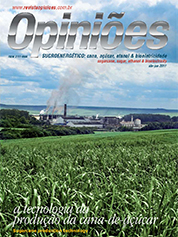Auro Pereira Pardinho
Marketing Manager at DMB
Op-AA-28
Mechanical Planting of Sugarcane
The mechanical planting of sugarcane was developed in Australia in the 70’s, in a production model characterized by small areas, usually family-run, very well done soil preparation, a well defined rain season, widely practiced irrigation, among other factors that contribute to the crop’s good development.
Attempts to introduce mechanical harvesting in Brazil in the 80’s and 90’s were frustrated by difficulties inherent to the Brazilian production model, involving planting in large areas, with soil preparation often done in a hastily manner, great concern about soil preservation, etc. However, the system did not take off, mainly due to abundant manual labor availability. Given that much of the sugarcane harvesting takes place in the offseason, it was only prudent that mills sought to retain that workforce.
With the gradual introduction of mechanical harvesting of sugarcane, labor started migrating to other areas. Since areas for planting were essentially small plots, in addition to reformation areas, this movement was not perceived. Between 2003/2004, when the race began to increase planting areas, brought about by good market prospects, one noticed the lack of labor for harvesting.
The implementation of new units made it possible to expand planting areas for sugarcane to new frontiers, on land previously used for grain or cattle breeding, for which little manual labor was needed, a fact that significantly worsened the problem. In this scenario, necessity made one resort to the mechanical planting of sugarcane, and from then on the search for sugarcane planters started to grow.
Currently only 10% of the planted area is serviced by mechanical planting, while projections foresee that in 2020 about 90% of the area will be mechanically planted. This is a no-return route. Mechanical planting grew more quickly than mechanical harvesting did in its days. Need made producers, manufacturers, managers, supervisors, leaders, workers, etc., unite, to prepare for learning and actually learning how to work with this new modality.
In order to adhere to the mechanical planting system, it does not suffice having capital and investing in machinery and infrastructure. It is necessary to be willing to learn how to plan, execute and control a new sugarcane planting system. Unlike planting grain, after a few months, one can plant again and correct possible errors made, whereas the sugarcane crop does not allow this.
After planting, one has to live with errors or right decisions for the next 5 years or more. The mechanical planting of sugarcane is influenced by a number of factors, which can have excellent or very poor outcomes. It requires special attention to four important items: soil preparation, quality of seedlings, labor needed in the process and planting as such.
Soil preparation has to take this time into account. Soil analyses at depths of 25 to 50 centimeters, the in-depth application of lime and gypsum, the elimination of compacted layers, tillage, harrowing and leveling of the planting area, are some of the practices that must be implemented to obtain an adequate basis for setting up future sugarcane plantations.
The well done preparation of soil also greatly facilitates the planter’s work, while maintaining uniformity in planting depth and in covering the furrows. Seed cane quality is another success factor. Seed cane must be between 7 and 10 months old and the harvester must have its metal parts that touch sugarcane buds, enveloped, so as to not damage them.
Cleaning seedlings is not to be forgotten. The very high cutting and too low cutting contribute to the accumulation of a lot of dry straw and green tips in the bin tractor. Since this material is lighter than the billets, when filling the planter, it stays on top, covering the seedlings and making it difficult for the operator to see, and to allow for adequate control of the flow of billets on the planter tracks.
This results in excessive usage of seedlings and major alterations in the uniformity of billet distribution in the planting furrows. Not to collect some of the buds is compensated by the cleaning procedure of the seedling load, because of uniformity and quality of the planting.
Quality of labor involved throughout the process is essential. The rule is to train the team. In the training room, one must gather planter and harvester operators, tractor drivers, supervisors, planting team leaders, and all other parties involved in the process, with the objective of bringing about mutual commitment in the quest for high quality labor, and understanding the concepts and mechanisms to monitor performance and controls of this new planting modality.
All parties involved come to understand the equipment, its mechanisms, how to tune it, operational controls and the necessary maintenance requirements. Finally, training must also take place in the planting field. Planting per se is the process’ realization and in this phase the planter’s performance is essential. DMB has worked on this project extracting the experience of each client serviced, viewed as privileged information on how to continuously improve and consolidate the system. Currently, DMB has a 49% market share in sugarcane planters in Brazil.
The secret of consolidating the success of this new system lies in accepting the idea of being part of a continuous learning process, with the quest for operational excellence standing out as the collective vision of the conquest to achieve. If some day we shall believe that we already know everything, undoubtedly we shall be ready to make major errors.




